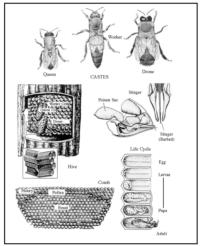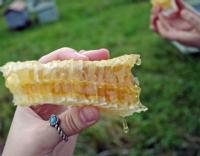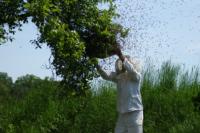Bee Biology and Behavior
Honey Bee Biology
Honey bees are one of the few insects that have a social structure, a caste, which consists of a single reproductive queen (only egg layer in the colony), numerous drones (males) depending on time of year, and a small number to about 60,000 worker bees or non-reproductive female bees. Honey bees undergo complete metamorphosis (holometabolism) and develop through four life stages, egg, larva, pupa, and adult. Several thousand worker bees cooperate in nest building, food collection, and brood rearing. Each honey bee in the worker caste has an age-related task to perform, which begins inside the hive (house bee) and eventually moves to foraging outside the hive. The immature forms of the bee are called the brood, and they are fed and cared for by the worker bee caste.
Hive maintenance
Like any good home, a honey bee hive needs to be maintained in order to produce a healthy and productive brood. Construction and maintenance of honey bee hives is conducted by the worker bee caste. Young adult honey bees convert excess food energy in their bodies to wax production rather than fat production. Wax glands are located on the underside of the abdominal segments, and the bees will use their legs to scrape off the produced wax and use it in honey comb production. Worker bees collect propolis from tree buds and use it like caulking to seal cracks and leaks around the hive. During hot summer days, the colony temperature must be reduced or the wax will melt and the bees will suffer, so they collect water and spread it on the interior of the nest and fan their wings, thereby causing evaporative cooling. As adult bees age, they perform the following tasks in this order: clean cells (house bees), circulate air with their wings, feed larvae, practice flying, receive pollen and nectar from foragers, guard hive entrance and eventually, they will move out of the hive and forage.
Seasonality
As the level of pollen, nectar and water sources change in the environment, the activity and maintenance of the hive changes in response. The changing conditions in the hive are enhanced in cold winter environments, and they are not as pronounced in tropical and sub-tropical environments.
SPRING: During spring when the days are longer and sources of pollen and nectar appear and increase, they stimulate egg laying by the queen and brood rearing. As such, the colony population increases, the worker force increases, and the number of foragers increase. Surplus collection of pollen and nectar are then stored to maintain brood rearing.
SUMMER: Day length in the summer is the longest and bees can then forage for extended periods, again collecting additional stores of pollen and nectar. However, in arid southern California, a reduced supply of nectar and pollen is available in the natural environment. The colony reaches peak population in the early summer.
FALL: Hive populations diminish in the fall in response to a reduction in the amount of nectar and pollen collected and reduced brood rearing. Additionally, the proportion of old bees in the colony decreases and is dependent on the age, health and fecundity of the queen.
WINTER: Whenever it’s cold, the bees will cluster around the eggs, larvae, and pupae and keep them warm through heat generated by the bees. Under subtropical, tropical, and mild winter conditions, egg laying and brood rearing are usually not affected.
Swarming
During early winter, the queen increases drone production by laying unfertilized eggs. This is in preparation of colony swarming. Workers are also likely to prepare to rear a new queen. A few early stage larvae are fed a special food called royal jelly and their cells are enlarged to accommodate the larger queen. Eventually, the original queen will leave the hive and a large number of worker bees will accompany her in search of a new hive location. After flying around in the air for several minutes, they will typically cluster on the limb of a tree or similar object, but they won’t stay there long. They will be gone the next day in search of a good place to start a new hive. Swarming generally occurs in the Central, Southern, and Western States from March to June, although it can occur at almost any time from April to October.
The remaining bees continue to work as normal with the exception of the care of the new queen larvae. When a new queen emerges from her cell, she searches for rival queens and destroys the cells. If a rival has emerged from its cell, the two queens will fight until one has eliminated the other. There can be only one queen. When the new queen is about a week old, she will mate with one or more drones outside the colony in the air. Within 3 or 4 days the mated queen begins egg laying.



